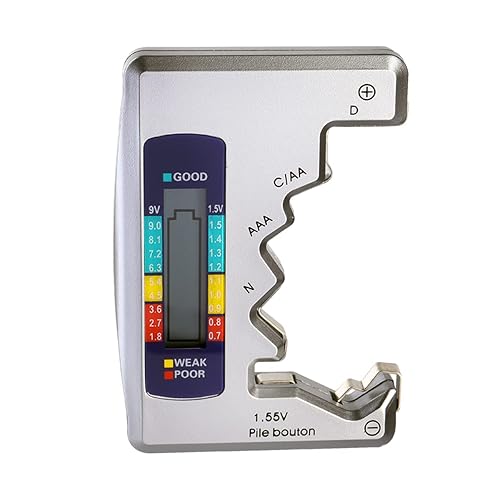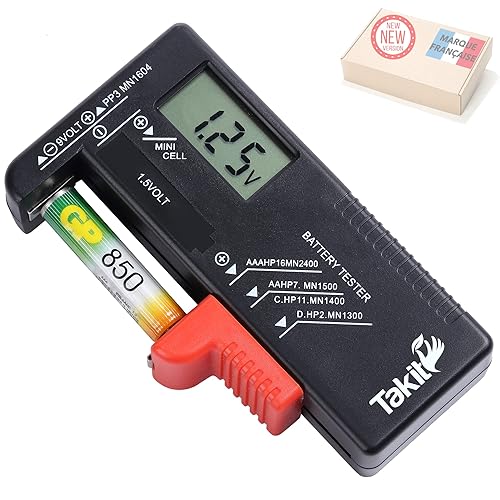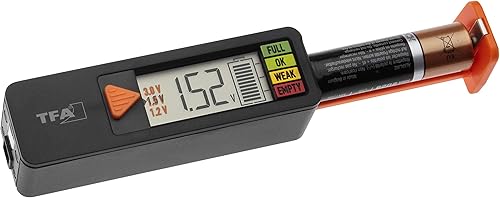How to Choose a Battery Tester in 2025? Guide and Comparison
Battery testers remain essential tools for anyone looking to extend the life of their electronic devices. With the multitude of battery-powered devices on the market, having a reliable tester not only allows you to assess the condition of your batteries but also helps you save money by identifying the ones that are still usable. Here's how to choose the ideal battery tester for your needs.
Our TOP 3
Treki

Pros
- Convenient
- Functional
- Easy to read
Cons
- Variable reliability
- Build quality
Specs
Takit

Pros
- Ease of use
- Reliability
- Value for money
Cons
- Limited functionality
Specs
Selection Criteria
Compatible Battery Types
When choosing a battery tester, ensure it is compatible with the types of batteries you frequently use. Testers are often designed to evaluate alkaline, NiMH, Li-ion, and more. For instance, if you primarily use AAA or AA batteries in your devices, a tester that supports these specifics will be crucial for optimal use.
Accuracy and Reliability
Accuracy is paramount when selecting a battery tester. A good tester should provide a reliable assessment of the battery's condition, clearly indicating if it is still usable, nearing the end of its life, or already discharged. Opt for devices that offer digital readings rather than a simple needle-type indication for more precision.
Ease of Use
A battery tester should be easy to use, even for inexperienced users. Look for models with clear displays and understandable indicators, such as colored LEDs or LCD screens. Auto-detection features for different types of batteries also add a layer of convenience.
Size and Portability
If you plan to use your tester in the field or transport it frequently, its size and weight are important criteria not to be overlooked. Compact and lightweight models will be more practical for a mobile user.
Common Mistakes
Improper Use
A common error is testing batteries that are not compatible with your device, which can lead to inaccurate readings. Always consult your tester's manual to verify compatibilities.
Ignoring Calibration
Over time, even the most precise devices can lose accuracy. Ensure you recalibrate your tester periodically to maintain optimal performance.
Overestimating Battery Condition
Some users blindly rely on digital readings without realizing that some models may provide an overly optimistic evaluation of the condition of used batteries. Always verify that the tester is recognized for its reliability.
Comparison of our 3 favorite products
Treki- Compact and portable

The Treki battery tester is perfect for those seeking a compact and lightweight device capable of testing a wide range of batteries. Thanks to its simple design and ease of use, it allows a quick identification of charge status with an intuitive color code.
Pros
- Convenient and lightweight
- Easy to read and use
- Versatile use
Cons
- Variable reliability according to some users
- Perceived inferior build quality
Takit- No battery required

The Takit tester stands out from its competitors with its battery-free operation thanks to self-activation during testing. Moreover, it is reliable and simple to use, allowing quick and efficient assessment of any battery without the need for external power.
Pros
- Ease of use
- Reliability
- No external power needed
- Good value for money
Cons
- Some functional limitations noted
TFA Dostmann- Precise voltage measurement

This TFA Dostmann battery tester is ideal for precise and quick assessments thanks to its digital voltage display. It offers impressive compactness and wide compatibility, making it an essential tool for checking the status of all kinds of batteries.
Pros
- Ease of use
- Precision and reliability
- Compact and versatile product
Cons
Practical Tips
Storage Environment: Keep your tester and batteries in a controlled temperature environment to avoid reading errors caused by extreme conditions.
Regular Testing: Establish a routine of regular testing for your batteries if they are not frequently used. This helps prevent unpleasant surprises of a dead battery at a critical moment.
Device Updates: If your tester allows it, check for software updates that could improve accuracy or add new useful features during checks.